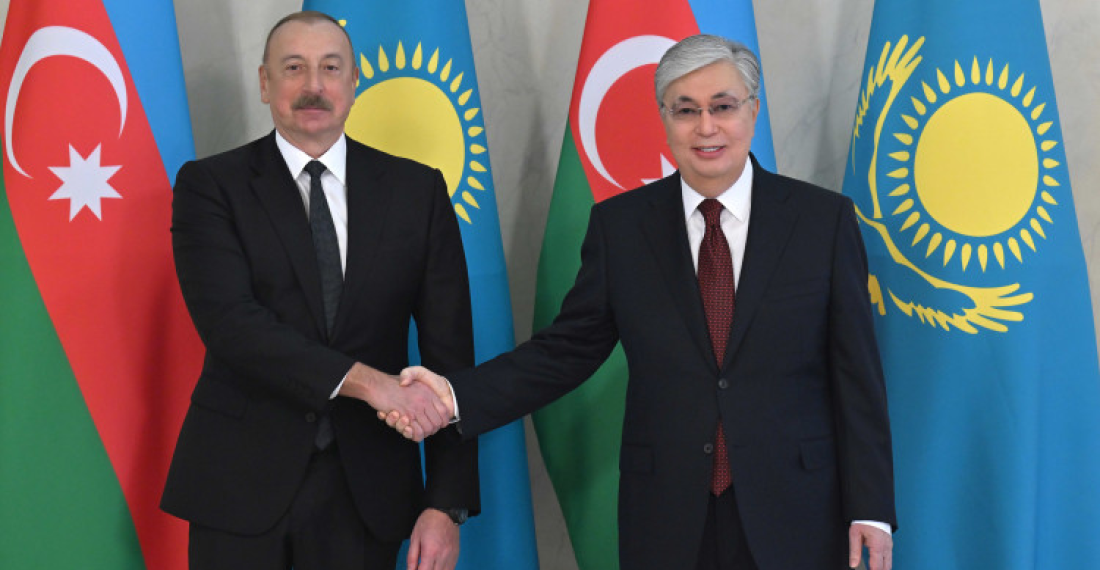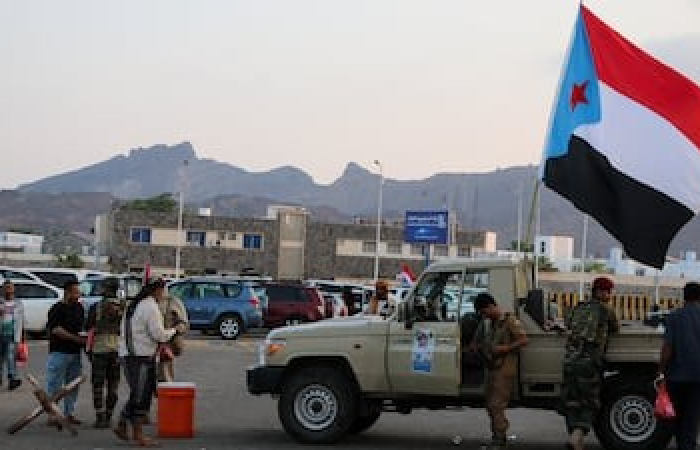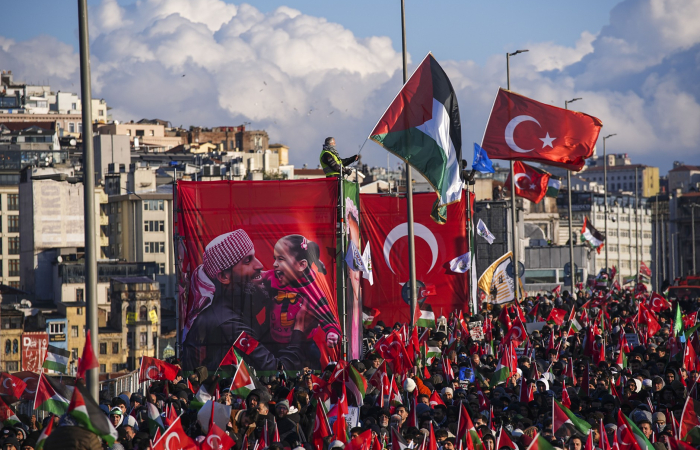"The 10 April meeting between and agreements signed by President Aliyev of Azerbaijan and President Tokayev of Kazakhstan demonstrate their desire to seize the day on developing this crucial linkage in the Middle Corridor trade route," writes commonspace.eu Deputy Editor Patrick Norén in this commentary. "Not only do Baku and Astana stand to gain hugely from this, but doing so quickly and in lock-step gets one step ahead of Russia and Iran for whom the Caspian Sea will also play an increasingly important economic role going forward."
On Monday 10 April, the presidents of Kazakhstan and Azerbaijan met in the former’s capital, Astana, to herald a new era of significantly upgraded cooperation between the two Caspian littoral states. President Kassym-Jomart Tokayev and President Aliyev signed numerous memoranda of understanding in a wide range of fields, including on economic, transport and transit, cultural, scientific and humanitarian cooperation.
That which has the most significant implications for regional connectivity, however, is their mutual commitment to rapidly increase trans-Caspian trade in an attempt to make the Middle Corridor a viable reality. Speaking in a press conference on Monday, President Tokayev said:
“The full deployment of the potential of the Trans-Caspian International Transport Route, the so-called Middle Corridor, is of particular importance. We are talking about the improvement of logistical services, the creation of unified transport operators, the modernization of technical and tariff conditions, the elimination of administrative barriers and the emergence of a closed logistical cycle.”
On his part, President Aliyev said, “Of course, we need to complement each other's infrastructure, each other's industrial potential through the goods we can supply to each other, thus increasing the turnover of goods”. He also announced the intention of the two countries to double their medium-term commodity turnover from $500m to $1bn.
The Middle Corridor is a complicated, piecemeal project with huge global implications
Having emerged as a potential alternative to the Northern Corridor - the trade route stretching from China to Europe via Russia now seriously hampered by sanctions - the Middle Corridor is currently being developed piecemeal, albeit very rapidly, as all actors along the route stand to profit hugely from its effective establishment. The fact that the Middle Corridor is multimodal, crossing two seas, as well as traversing several countries, makes overcoming these logistical difficulties a particularly acute priority.
In December 2022, Hungary, Romania, Georgia and Azerbaijan all agreed on the Black Sea Electricity Project in a potential sign of things to come once Black Sea security is stabilised. Georgia is reviving a project to build a strategically important deep-sea port at Anaklia, and has for years been building a new East-West highway through its mountainous interior, critical for the whole Middle Corridor project, although this has not been without difficulties, however.
China meanwhile, despite recent declarations of a “no limits partnership” with Russia, is pushing increased cooperation with “Moscow’s backyard” in Central Asia, setting up the first China-Central Asia leaders summit in May where trade and infrastructure are set to be at the top of the agenda.
In addition to the above, as seamless as possible trade between Kazakhstan and Azerbaijan, being on opposing sides of the Caspian Sea, is absolutely essential if the Middle Corridor is to be a viable alternative to the Northern Corridor in the long-term. Baku and Astana understand this, and, with both countries standing to gain so much from facilitating East-West trade following the effective closure of the Northern Corridor, have decided that there is no time to lose.
Having remained largely economically dependent on Russia since the fall of the Soviet Union, for Central Asia the Middle Corridor is their chance to comprehensively diversify their political and economic relations. A viable Middle Corridor is Central Asia’s ticket to reducing economic dependence on Russia, whose economy is suffering under the weight of western sanctions, while expanding access to Chinese and European markets without having to go through Russia.
Time is of the essence
For Kazakhstan and Azerbaijan, cementing control over trans-Caspian trade as quickly as possible is just as much a political priority as it is an economic necessity. Russia had counted on using the Caspian Sea as a North-South transport corridor with its ally Iran to help soften the blow caused by western economic sanctions, but significant infrastructural limitations are frustrating the realisation of this project, giving Baku and Astana the upper hand.
Russian ports on the Caspian do not currently possess the adequate infrastructure to transfer huge amounts of goods from one mode of transport to another, there are serious financial limitations, a lack of sufficient shipping capacity, as well as limited icebreaker capacity to keep the ports functional in winter.
And, although all of Russia’s Caspian Sea ports are connected to the national railway network, only one Iranian Caspian Sea port currently has direct access to their railway network, yet another weakness in the Russia-Iran, North-South multimodal transport corridor. These are issues that Russia and Iran are trying to address, and so Kazakhstan and Azerbaijan are pressing home their head start over Russia and Iran on Caspian Sea trade. Removing as many bureaucratic and infrastructural barriers on the East-West route, and quickly too, is of utmost importance.
The risk of blockades, or, even worse, conflict, must be managed
This situation where two competing and rapidly expanding trade routes with enormous geopolitical implications bisect in the middle of the Caspian Sea will likely mean that tensions between Russia, Iran, Azerbaijan and Kazakhstan rise. This is even more probable considering that relations between Russia and Azerbaijan, Azerbaijan and Iran, and Russia and Kazakhstan remain testy at best. The risk of blockades, or, even worse, outright conflict, potentially having an equally damaging effect on global trade as did Russia’s full-scale invasion of Ukraine, is real and must be delicately managed.
The 10 April meeting between and agreements signed by President Aliyev of Azerbaijan and President Tokayev of Kazakhstan demonstrate their desire to seize the day on developing this crucial linkage in the Middle Corridor trade route. Not only do Baku and Astana stand to gain hugely from this, but doing so quickly and in lock-step gets one step ahead of Russia and Iran for whom the Caspian Sea will also play an increasingly important economic role going forward.






